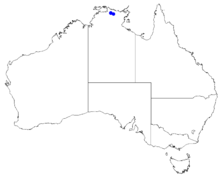Boronia viridiflora
Boronia viridiflora is a species of shrub that is endemic to a small area in the Northern Territory and grows horizontally from vertical rock faces. The flowers are borne singly or in groups of up to three in leaf axils and are green with a burgundy tinge.
| Boronia viridiflora | |
|---|---|
| Scientific classification | |
| Kingdom: | Plantae |
| Clade: | Tracheophytes |
| Clade: | Angiosperms |
| Clade: | Eudicots |
| Clade: | Rosids |
| Order: | Sapindales |
| Family: | Rutaceae |
| Genus: | Boronia |
| Species: | B. viridiflora |
| Binomial name | |
| Boronia viridiflora | |
 | |
| Occurrence data from Australasian Virtual Herbarium | |
Description
Boronia viridiflora is a shrub that typically grows to a height of about 1.5–2 m (4 ft 11 in–6 ft 7 in) growing horizontally from vertical rock faces. The plant is glabrous apart from the petals. Its leaves are elliptical to lance-shaped, 8–40 mm (0.31–1.57 in) long and 7–16 mm (0.28–0.63 in) wide on a petiole 0.5–3.5 mm (0.020–0.138 in) long. The flowers are borne singly or in groups of up to three in leaf axils on a peduncle 0.5–3 mm (0.020–0.118 in) long. The flowers are surrounded by leaf-like prophylls 0.5–12 mm (0.020–0.472 in) long and 1–3 mm (0.039–0.118 in) wide and the sepals are egg-shaped to triangular, about 3 mm (0.12 in) long, 2 mm (0.079 in) wide and green and burgundy-coloured. The petals are green, about 3 mm (0.12 in) long and 2 mm (0.079 in) wide. The sepals and petals do not enlarge significantly as the fruit develops. Flowering occurs between March and September and the fruit is a glabrous capsule about 5 mm (0.20 in) long and 3 mm (0.12 in) wide.[2][3]
Taxonomy and naming
Boronia viridiflora was first formally described in 1997 by Marco F. Duretto who published the description in the journal Australian Systematic Botany.[4] The specific epithet (viridiflora) is derived from the Latin viridis meaning "green" and -florus meaning "-flowered",[5][6] referring to the colour of the flowers.[4]
Distribution and habitat
This boronia is only known from two populations that grow on vertical sandstone rock faces in privately managed land in Arnhem Land.[2][7]
Conservation status
This species is classified as "vulnerable" under the Australian Government Environment Protection and Biodiversity Conservation Act 1999 and the Territory Parks and Wildlife Conservation Act 2000.[3][7] Prior to 2006, the estimated population size was estimated to be about 700, but Cyclone Monica may have had severely damaged the populations and the current population size is unknown. The populations are also threatened by altered fire regimes.[7][8] A National Recovery Plan for this species and B. quadrilata has been prepared.[9]
References
- "Boronia viridiflora". APC. Retrieved 13 March 2020.
- Duretto, Marco F. (1999). "Systematics of Boronia section Valvatae sensu lato (Rutaceae)" (PDF). Muelleria. 12 (1): 91–92. Retrieved 13 March 2020.
- "Boronia viridiflora". Northern Territory Government flora online. Retrieved 13 March 2020.
- "Boronia viridiflora". APNI. Retrieved 13 March 2020.
- Francis Aubie Sharr (2019). Western Australian Plant Names and their Meanings. Kardinya, Western Australia: Four Gables Press. p. 336. ISBN 9780958034180.
- William T. Stearn (1992). Botanical Latin. History, grammar, syntax, terminology and vocabulary (4th ed.). Portland, Oregon: Timber Press. p. 528.
- "Australian Threatened Species - Boronia viridiflora" (PDF). Australian Government Department of the Environment. Retrieved 13 March 2020.
- "Rare plant threatened by Cyclone Monica". Charles Darwin University. Retrieved 13 March 2020.
- "National Recovery Plan for Boronia quadrilata and Boronia viridiflora in the Northern Territory of Australia" (PDF). Parks and Wildlife Service of the Northern Territory Conservation and Natural Resources Division Department of Natural Resources, Environment and the Arts.

